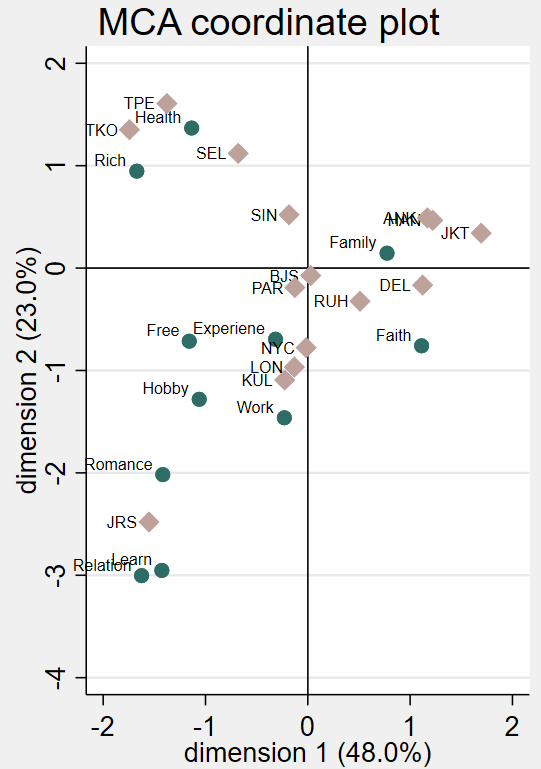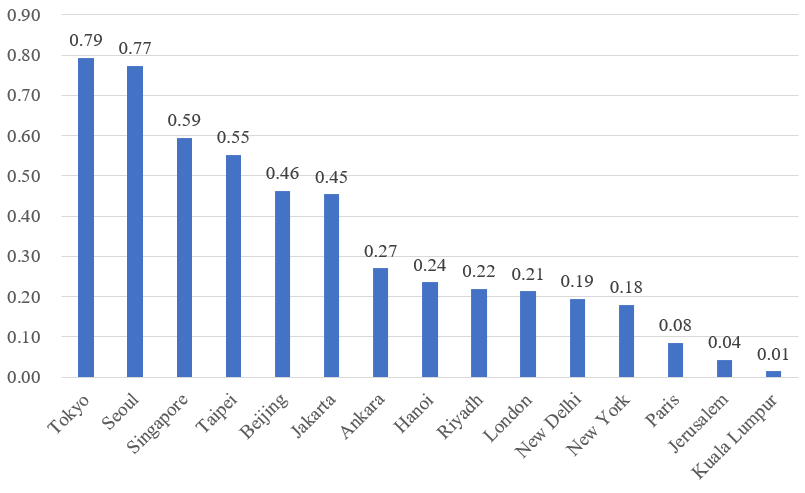Social Values Survey in Asian Cities: Analysis of the Results on Values and the Meaning of Life
Seoul National University Asia Research Center, along with Korea Research, conducted a survey in 2022 on social values and the meaning of life. As part of this survey, participants were asked to rate the importance of 11 options relating to one’s meaning of life. The results of the survey and the subsequent application of multiple correspondence analysis undertaken on the results provide some interesting implications of the perception of values amongst the city dwellers of Asia.
Admittedly, comparisons between countries based on the survey data need to be approached with caution. For example, there may have been slight differences in the nuances of the survey form, which was translated into 12 different languages. In addition, because the survey was targeted only at the residents of major cities, the results cannot be seen to represent the opinions of each country as a whole. Nevertheless, there are interesting patterns that can be observed between the countries of Asia, which may be further explored in the future to obtain key insights into the similarities and differences in perceptions regarding ‘value’ in Asia.
The “Social Values Survey in Asian Cities” was carried out in 15 cities: Seoul, Tokyo, Beijing, Singapore, Taipei, Hanoi, Jakarta, Kuala Lumpur, New Delhi, Riyadh, Jerusalem, Ankara, London, Paris, and New York. The size of study subjects is 10,500, which consists of 700 adults per city. The participants of the survey were first asked to rate the importance of the following 11 options in terms of their contribution to one’s meaning of life: (1) family, (2) occupation and career, (3) material well-being, (4) relationships with close acquaintances, (5) health, (6) freedom, (7) hobbies and recreation, (8) education or learning, (9) romantic relationships, (10) new experiences, and (11) faith. In addition, participants were also asked to select the three most important options among the 11 and rank them in terms of their significance.
Because the survey targeted 15 cities, it is not an easy task to visualize how each of the cities responded to each of the 11 items using tables or graphs. Therefore, in order to more effectively examine the differences between cities, multiple correspondence analysis was used. This is a methodological approach that can effectively visualize the number of people that selected a given option as the most important one in terms of meaning of life, allowing country-by-country comparisons. The results of the analysis are illustrated in Figure. 1.

Fig. 1: Results of the multiple correspondence analysis demonstrating the relationship between the 15 cities that participated in the survey (diamond) and the 11 options associated with the meaning of life (dot). The names of the cities are abbreviated as follows: Tokyo - TKO, Seoul - SEL, Singapore - SIN, Taipei - TPE, Beijing - BJS, Jakarta - JKT, Ankara - ANK, Hanoi - HAN, Riyadh - RUH, London - LON, New Delhi - DEL, New York - NYC, Paris - PAR, Jerusalem - JRS, Kuala Lumpur – KUL. (Figure courtesy of the author, 2023)
The distance between two cities or two options in Figure 1 represents the degree of correspondence, which was measured by focusing on ‘relative importance.’ For example, in the case that Option A was selected by the greatest number of survey respondents of a given city as one of the three most important options regarding the meaning of life, if the proportion of respondents who chose A is relatively low compared to other cities but the proportion of respondents who chose B is relatively high (although the absolute proportion is low), then that city is displayed as being closer to B. More specifically, the way to interpret the graph is as follows. After connecting a line from two points on the graph to the origin, the smaller the angle between the two lines, the higher the probability of the two points being selected at the same time; a larger angle indicates a relatively lower probability of the two being selected together. For example, the ratio of “health” and “material well-being” (labeled as “Rich”) being selected together with “Seoul” (labeled as “SEL”) was found to be relatively high, but the correspondence with “faith” was relatively low. The fact that the angle between “Seoul” and “family” is close to 90° indicates that the correspondence was found to be of an average degree – that is, the mean with respect to all cities.
Overall, a similar pattern could be observed for the cities of Northeast Asia and Singapore, with the exclusion of Beijing. In the case of these cities, “health” and “material well-being” were regarded as being relatively more important, and “faith” less so. It could also be observed that respondents from Tokyo (22.3 percent) or Taipei (17.0 percent) were more likely to choose “material well-being” as an important component of the meaning of life, compared to Seoul (13.7 percent).
One of the key criticisms of South Korean society that emerged as a result of the Pew Research Center’s Global Attitudes Survey was that Koreans were only interested in material wealth and placed little value on enhancing the well-being of one’s inner self. A simple additional analysis was therefore conducted to see the extent to which such criticisms could be confirmed through this survey. The average of respondents’ answers about the significance of three factors – (1) hobbies and recreation, (2) education or learning, and (3) new experiences – to their meaning of life was compared against the importance of material well-being. Variables were then constructed by calculating the difference, with higher values indicating that respondents had regarded material well-being to be more important than the other, non-material options. The average of these values by city is shown in Figure 2.

Fig. 2: Values indicating the difference between the average of respondents’ answers about the significance of three categories – (1) hobbies and recreation, (2) education or learning, and (3) new experiences – were to their meaning of life compared against the importance of material well-being, according to city.(Figure courtesy of the author, 2023)
The graph presented in Figure 2 illustrates that, among the 15 cities, respondents from Tokyo and Seoul placed the highest relative importance on material well-being. Interestingly enough, in the case of Seoul, the absolute degree of importance placed on material well-being is indeed higher than in other cities, but it is not overwhelmingly high: Seoul was fourth out of 15 cities. However, since the degree to which hobbies and recreation, education or learning, and new experiences were seen to contribute to the meaning of life is relatively low for Seoul (12th out of 15 cities), the gap between the two types of values was greater than in most other cities. In other words, in the case of Seoul, the importance of material well-being appears to be relatively more prominent because the degree of meaning gained from the non-material sphere is seen to be relatively insignificant.
The analysis of the data from the “Social Values Survey in Asian Cities” is ongoing, and only some preliminary results were presented in this piece. Differences between countries are based on cultural differences, and so we must be careful about making any absolute value judgments. Nevertheless, the findings of the survey seem to suggest that the residents of Northeast Asian cities tend to regard material well-being and health as key elements of their meaning of life, and such residents place relatively less importance on the activities that may enrich their lives in . Perhaps this is because the latter are regarded as something that can or should only be achieved when the former is sufficient. This mindset and other implications obtained from the survey will require further investigation in the future.
Dong-Kyun Im, Associate Professor, Department of Sociology, Seoul National University. Email: dongkyunim@snu.ac.kr